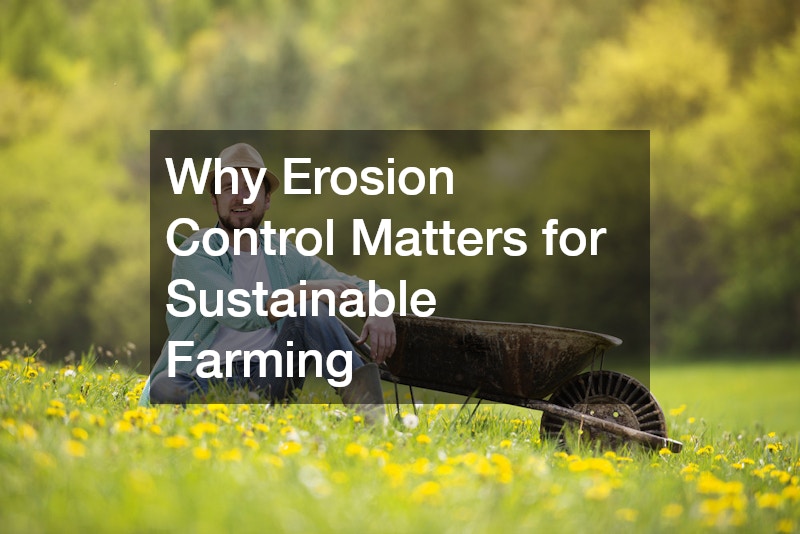Sustainable farming is essential to meet the growing demand for food while protecting the environment for future generations. Among the many challenges farmers face, soil erosion ranks as one of the most serious. Soil erosion threatens not only crop yields but also the very foundation of farming: healthy soil. Effective erosion control strategies are vital for maintaining soil health, preserving natural resources and ensuring the long-term viability of farmland.
The Consequences of Soil Erosion on Farmland
Soil erosion occurs when the topsoil—the most fertile and nutrient-rich layer—is worn away by wind, water or farming activities. This topsoil contains essential minerals and organic matter that plants need to grow.
When it is lost, farms suffer immediate and lasting effects.
One of the most obvious impacts of soil erosion is the reduction in crop yields. Without nutrient-rich soil, plants become weaker and less productive. Farmers then need to apply more fertiliser to maintain yields, increasing costs and environmental risks. The loss of organic matter also harms the soil’s ability to retain moisture and support beneficial microorganisms. This results in soil that is drier and more prone to further degradation.
In Australia, many farms are located on slopes or in regions with intense seasonal rains, which exacerbate erosion risks. When soil washes into waterways, it causes sediment build-up that damages aquatic habitats and reduces water quality. This not only affects the farm but also downstream communities and ecosystems, making soil erosion a widespread problem.
Practical Soil Conservation & Protection Strategies
Farmers use a range of techniques to reduce soil loss and improve land stability. These methods form the backbone of erosion control on farms and are often combined for maximum effect.
Contour farming involves ploughing and planting along the natural contours of the land rather than straight up and down slopes. This slows water runoff, allowing it to soak into the ground and preventing soil from being swept away. On steep hillsides, terracing creates a series of flat steps, which further reduces water speed and soil displacement.
Cover cropping is another important strategy. Farmers plant temporary crops such as legumes or grasses during off-season periods. These cover crops protect the soil surface from rain and wind, hold the soil in place with their roots and add organic matter when they decompose. They also improve soil structure and help retain moisture, all of which reduce the chance of erosion.
Buffer strips of vegetation are planted alongside rivers and creeks to act as natural filters. These strips trap sediment and absorb excess nutrients before they reach waterways. In Australia, many farmers choose native plants for these buffers because they thrive locally and provide habitat for wildlife.
Sustainable Farming Practices That Support Soil Health
Beyond specific erosion control methods, adopting broader sustainable farming practices enhances soil resilience over the long term. Crop rotation is one such practice, where farmers alternate the types of crops grown in a field each season. This prevents the depletion of particular nutrients and breaks pest and disease cycles, leading to healthier soils.
Reduced tillage or no-till farming minimises soil disturbance. Traditional ploughing breaks up soil structure and exposes it to erosion, but by limiting this, the soil remains intact and its natural microbial life thrives. This helps maintain soil stability and fertility.
Organic farming techniques complement these approaches by focusing on building soil organic matter through compost and natural fertilisers. Healthy soil rich in organic material is less vulnerable to erosion and better at holding water during dry spells.
Support for Farmers & Community Efforts
Recognising the importance of soil conservation, Australian governments offer various programs to assist farmers. These include funding grants, expert advice and training workshops to help farmers adopt best practices.
Community groups and landcare networks also play a vital role. Many regional projects bring together neighbours to manage erosion hotspots, plant native vegetation and restore damaged landscapes. These collective efforts build stronger local ecosystems and promote a shared responsibility for land stewardship.
Soil erosion poses a significant threat to farming sustainability in Australia. The loss of fertile topsoil reduces crop productivity, harms soil structure and pollutes waterways. Implementing effective measures to prevent soil loss is essential to protect farmland, maintain soil health and safeguard the environment.
When farmers combine soil preservation techniques with sustainable practices like crop rotation, reduced tillage and organic soil management, they build resilience against erosion and support long-term productivity. Government programs and community involvement further strengthen these efforts, ensuring that soil conservation remains a priority.
In the end, protecting soil is not just about preventing erosion; it is about securing the future of Australian farming and the wider environment. Sustainable farming practices that preserve soil benefit farmers, communities and ecosystems alike, creating a balanced and thriving agricultural landscape for generations to come. By valuing soil health and adopting careful land management, farmers contribute to food security, water quality and biodiversity, ensuring the land remains productive and resilient through changing climates and economic challenges.
.





